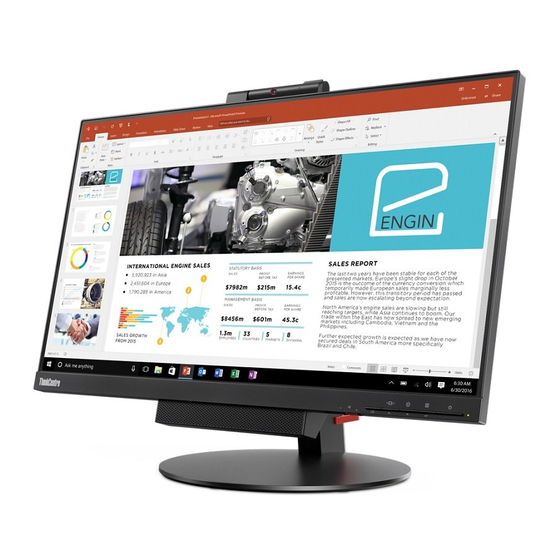Lenovo 10QX-PAR1-WW User Manual - Page 21
Browse online or download pdf User Manual for Monitor Lenovo 10QX-PAR1-WW. Lenovo 10QX-PAR1-WW 49 pages.

Comfort and accessibility
Good ergonomic practice is important to get the most from your personal computer and to avoid
discomfort. Arrange your workplace and the equipment you use to suit your individual needs and the kind
of work that you perform. In addition, use healthy work habits to maximize your performance and
comfort while using your computer.
Arranging your work area
Use a work surface of appropriate height and available working area to allow you to work in comfort.
Organize you work area to match the way you use materials and equipment. Keep your work area clean
and clear for the materials that you typically use and place the items that you use most frequently, such as
the computer mouse or telephone, within the easiest reach.
Equipment layout and setup play a large role in your working posture. The following topics describe how
to optimize equipment setup to achieve and maintain good working posture.
Positioning and viewing your monitor:
Position and adjust your computer monitor for comfortable viewing by considering the following items:
•
•
•
•
The following are some other tips for comfortable viewing of your monitor:
•
•
•
Viewing distance:
Optimal viewing distances for monitors range from approximately 510mm to 760mm (20 in to 30
in) and can vary depending on ambient light and time of day. You can achieve different viewing
distances by repositioning your monitor or by modifying your posture or chair position. Use a
viewing distance that is most comfortable for you.
Monitor height:
Position the monitor so your head and neck are in a comfortable and neutral (vertical, or upright)
position. If your monitor does not have height adjustments, you might have to place books or other
sturdy objects under the base of the monitor to achieve the desired height. A general guideline is to
position the monitor such that the top of the screen is at or slightly below your eye-height when you
are comfortably seated. However, be sure to optimize your monitor height so the line of site between
your eyes and the center the monitor suits your preferences for visual distance and comfortable
viewing when your eye muscles are in a relaxed stated.
Tilt&Swivel&Pivot:
Adjust the tilt, swivel and pivot of your monitor to optimize the appearance of the screen content
and to accommodate your preferred head and neck posture.
General location:
Position your monitor to avoid glare or reflections on the screen from overhead lighting or nearby
windows.
Use adequate lighting for the type of work you are performing.
Use the monitor brightness, contrast, and image adjustment controls, if equipped, to
optimize the image on your screen to meet your visual preferences.
Keep your monitor screen clean so you can focus on the screen's contents.
Any concentrated and sustained visual activity can be tiring for your eyes. Be sure to periodically
look away from your monitor screen and focus on a far object to allow your eye muscles to relax. If
you have questions on eye fatigue or visual discomfort, consult a vision care specialist for advice.
2-6
Chapter 2.
